Different Types of Thermometers
Key Difference: Thermometers are devices used for the measurement of temperature. They are mainly of two types – electrical and non-electrical. Thermometers based on mechanisms like mercury in glass or vapor pressure fall in the non-electrical types, whereas electrical ones usually use semiconductors like diodes and resistors in them.
Thermometer has been derived from a Greek words thermo and meter, where thermo means heat and meter means to measure. It is an important device used for the measurement of temperature or temperature gradient. There are many different types of thermometers which measure the temperature but use different types of methods.
To get familiar with the thermometers one needs to be aware of some common types of thermometers which are listed here –
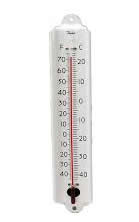 Glass Tube thermometers – These thermometers are very common. They make use of the property of fluids like mercury. The expansion of fluids on applying heat is the central idea of these thermometers. It has two basic parts – one is the bubble which holds the liquid and the other is stem which comprises of the scale and a capillary through which liquid expands or contracts. They are found in abundance in market and they are cheap and easy to carry. One of the biggest disadvantages with these thermometers is that they are not capable in measuring sudden temperature variations.
Glass Tube thermometers – These thermometers are very common. They make use of the property of fluids like mercury. The expansion of fluids on applying heat is the central idea of these thermometers. It has two basic parts – one is the bubble which holds the liquid and the other is stem which comprises of the scale and a capillary through which liquid expands or contracts. They are found in abundance in market and they are cheap and easy to carry. One of the biggest disadvantages with these thermometers is that they are not capable in measuring sudden temperature variations.
 Bimetal thermometer – They are mainly employed for measuring the temperature of gases and liquids. It comprises of an element which is formed by putting two different metallic materials together. When temperature is deducted, the metallic elements want to expand, and due to their different compositions their rate of expansion also varies. This stress is reflected in the element which is in the form of a flat spring, and their motion is reflected by the indicator. They are quiet accurate in general.
Bimetal thermometer – They are mainly employed for measuring the temperature of gases and liquids. It comprises of an element which is formed by putting two different metallic materials together. When temperature is deducted, the metallic elements want to expand, and due to their different compositions their rate of expansion also varies. This stress is reflected in the element which is in the form of a flat spring, and their motion is reflected by the indicator. They are quiet accurate in general.
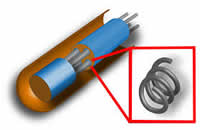 Resistance Thermometers – These thermometers work on the principal that electrical resistance varies in pure metals with accord to temperature. Thermal vibrations hinder the flow of electrons in a metal. As the temperature increases, the resistance also increases, and this very idea is the central concept of this thermometer. Generally, they make use of platinum wires for the thermometer, however copper, nickel and rhodium alloy can also be sometimes used for different temperature ranges. They are known for their high accuracy. However, they are expensive than liquid in glass thermometers.
Resistance Thermometers – These thermometers work on the principal that electrical resistance varies in pure metals with accord to temperature. Thermal vibrations hinder the flow of electrons in a metal. As the temperature increases, the resistance also increases, and this very idea is the central concept of this thermometer. Generally, they make use of platinum wires for the thermometer, however copper, nickel and rhodium alloy can also be sometimes used for different temperature ranges. They are known for their high accuracy. However, they are expensive than liquid in glass thermometers.
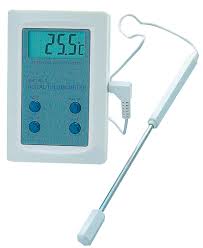 Digital Thermometers – These mercury free thermometers are easy to use and the reading is displayed in a more convenient form. They contain thermo sensors like thermistor inside the tip which senses the temperature and provides instant and accurate results especially over the body temperature range. Thermistor is basically a resistor whose resistance changes with change in temperature. It can be used for recording oral, auxiliary and rectal temperatures.
Digital Thermometers – These mercury free thermometers are easy to use and the reading is displayed in a more convenient form. They contain thermo sensors like thermistor inside the tip which senses the temperature and provides instant and accurate results especially over the body temperature range. Thermistor is basically a resistor whose resistance changes with change in temperature. It can be used for recording oral, auxiliary and rectal temperatures.
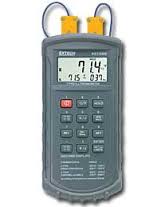 Thermocouple thermometer – These thermometer are used for measurements of difference in temperature between two points. Therefore, it is not used for measurement of absolute temperature. It is based on effects discovered by Seedbeck, Peltier and Thomson. It is made by different metals which are joined at the sensor rate. The temperature differential is calculated by calculating the difference in voltages between the metals. Thus, for measuring temperature, it must have some reference to the known temperature.
Thermocouple thermometer – These thermometer are used for measurements of difference in temperature between two points. Therefore, it is not used for measurement of absolute temperature. It is based on effects discovered by Seedbeck, Peltier and Thomson. It is made by different metals which are joined at the sensor rate. The temperature differential is calculated by calculating the difference in voltages between the metals. Thus, for measuring temperature, it must have some reference to the known temperature.
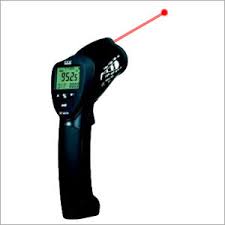 Infrared Thermometers – These thermometers use a crystal which is sensitive to infrared or heat radiation. When it detects heat, then it emits a signal and this signal’s strength provides the temperature reading. Bolometers and Pyrometers also fall in the category of some different types of infrared thermometers. One of the exclusive qualities of it is that it is based on non- contact mechanism which makes them really easy to use. The biggest disadvantage of it is that it is only able to measure the temperature of the surface of the object.
Infrared Thermometers – These thermometers use a crystal which is sensitive to infrared or heat radiation. When it detects heat, then it emits a signal and this signal’s strength provides the temperature reading. Bolometers and Pyrometers also fall in the category of some different types of infrared thermometers. One of the exclusive qualities of it is that it is based on non- contact mechanism which makes them really easy to use. The biggest disadvantage of it is that it is only able to measure the temperature of the surface of the object.
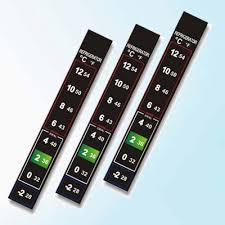 Liquid Crystal Thermometer - They make use of cholesteric liquid crystals. They express temperatures as colors. They are able to detect change in temperature occurring due to flow of heat by conduction, radiation or convection. The designated temperature appears darker on the face to reflect the reading.
Liquid Crystal Thermometer - They make use of cholesteric liquid crystals. They express temperatures as colors. They are able to detect change in temperature occurring due to flow of heat by conduction, radiation or convection. The designated temperature appears darker on the face to reflect the reading.
Image Courtesy: coleparmer.com, news.thomasnet.com, nist.gov, homebrewers.com, integritydesign.com, gpsystems.tradeindia.com, allafrance.com






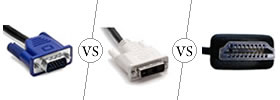


Add new comment